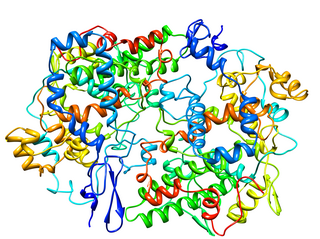Related Research Articles
Nonsteroidal anti-inflammatory drugs (NSAIDs) are members of a drug class that reduces pain, decreases fever, prevents blood clots, and in higher doses, decreases inflammation. Side effects depend on the specific drug but largely include an increased risk of gastrointestinal ulcers and bleeds, heart attack, and kidney disease.

Cyclooxygenase (COX), officially known as prostaglandin-endoperoxide synthase (PTGS), is an enzyme that is responsible for formation of prostanoids, including thromboxane and prostaglandins such as prostacyclin, from arachidonic acid. A member of the animal-type heme peroxidase family, it is also known as prostaglandin G/H synthase. The specific reaction catalyzed is the conversion from arachidonic acid to Prostaglandin H2, via a short-living Prostaglandin G2 intermediate.

In the fields of medicine, biotechnology and pharmacology, drug discovery is the process by which new candidate medications are discovered.

Celecoxib, sold under the brand name Celebrex among others, is a COX-2 inhibitor and nonsteroidal anti-inflammatory drug (NSAID). It is used to treat the pain and inflammation in osteoarthritis, acute pain in adults, rheumatoid arthritis, ankylosing spondylitis, painful menstruation, and juvenile rheumatoid arthritis. It may also be used to decrease the risk of colorectal adenomas in people with familial adenomatous polyposis. It is taken by mouth. Benefits are typically seen within an hour.
COX-2 inhibitors are a type of nonsteroidal anti-inflammatory drug (NSAID) that directly targets cyclooxygenase-2, COX-2, an enzyme responsible for inflammation and pain. Targeting selectivity for COX-2 reduces the risk of peptic ulceration and is the main feature of celecoxib, rofecoxib, and other members of this drug class.
G.D. Searle, LLC is a wholly owned trademark of Pfizer. It is currently used mainly as a distribution trademark for various pharmaceuticals that were developed by G. D. Searle & Company. Prior to its 1985 merger with Monsanto, Searle was a company focusing on life sciences, specifically pharmaceuticals, agriculture, and animal health.

Etodolac is a nonsteroidal anti-inflammatory drug (NSAID).

Amprenavir is a protease inhibitor used to treat HIV infection. It was approved by the Food and Drug Administration on April 15, 1999, for twice-a-day dosing instead of needing to be taken every eight hours. The convenient dosing came at a price, as the dose required is 1,200 mg, delivered in 8 (eight) very large 150 mg gel capsules or 24 (twenty-four) 50 mg gel capsules twice daily.

Parecoxib, sold under the brand name Dynastat among others, is a water-soluble and injectable prodrug of valdecoxib. Parecoxib is a COX2 selective inhibitor. It is injectable. It is approved through much of Europe for short term perioperative pain control.
Jeffery W. Kelly is an American chemist and entrepreneur who is on the faculty of the Scripps Research Institute in La Jolla, California.
Bruce D. Roth is an American organic and medicinal chemist who trained at Iowa State University and the University of Rochester, and, at the age of 32, discovered atorvastatin, the statin-class drug sold as Lipitor that would become the largest-selling drug in pharmaceutical history. His honours include being named a 2008 Hero of Chemistry by the American Chemical Society, and being chosen as the Perkin Medal awardee, the highest honour given in the U.S. chemical industry, by the Society of Chemical Industry, American section in 2013.
Cyclooxygenases are enzymes that take part in a complex biosynthetic cascade that results in the conversion of polyunsaturated fatty acids to prostaglandins and thromboxane(s). Their main role is to catalyze the transformation of arachidonic acid into the intermediate prostaglandin H2, which is the precursor of a variety of prostanoids with diverse and potent biological actions. Cyclooxygenases have two main isoforms that are called COX-1 and COX-2. COX-1 is responsible for the synthesis of prostaglandin and thromboxane in many types of cells, including the gastro-intestinal tract and blood platelets. COX-2 plays a major role in prostaglandin biosynthesis in inflammatory cells and in the central nervous system. Prostaglandin synthesis in these sites is a key factor in the development of inflammation and hyperalgesia. COX-2 inhibitors have analgesic and anti-inflammatory activity by blocking the transformation of arachidonic acid into prostaglandin H2 selectively.
Many major physiological processes depend on regulation of proteolytic enzyme activity and there can be dramatic consequences when equilibrium between an enzyme and its substrates is disturbed. In this prospective, the discovery of small-molecule ligands, like protease inhibitors, that can modulate catalytic activities has an enormous therapeutic effect. Hence, inhibition of the HIV protease is one of the most important approaches for the therapeutic intervention in HIV infection and their development is regarded as major success of structure-based drug design. They are highly effective against HIV and have, since the 1990s, been a key component of anti-retroviral therapies for HIV/AIDS.

Mavacoxib is a veterinary drug used to treat pain and inflammation in dogs with degenerative joint disease. It acts as a COX-2 inhibitor.
Ironwood Pharmaceuticals, Inc is a publicly traded pharmaceutical company. It was originally called Microbia, Inc..
Philip Needleman is an American pharmacologist and academic. Needleman was a professor and associate dean at the Washington University School of Medicine and he served as an executive at Monsanto/Searle. He is credited with discovering the first thromboxane synthase inhibitor, the inflammatory substance known as COX-2 and the cardiac hormone known as atriopeptin. Needleman is a member of the National Academy of Sciences and a Fellow of the American Academy of Arts and Sciences.
Dumbala Srinivasa Reddy is an Indian organic and medicinal chemist and a senior scientist at National Chemical Laboratory. He is known for the application of Silicon-switch approach, a management protocol for treating diseases affecting the central nervous system in his researches and is a recipient of the Bronze Medal of the Chemical Research Society of India, NASI-Reliance Industries Platinum Jubilee Award and the Drug Research Excellence Award of the Central Drug Research Institute. The Council of Scientific and Industrial Research, the apex agency of the Government of India for scientific research, awarded him the Shanti Swarup Bhatnagar Prize for Science and Technology, one of the highest Indian science awards, in 2015, for his contributions to chemical sciences.

Joshua S. Boger is an organic chemist and the founder of Vertex Pharmaceuticals Incorporated. He is considered a pioneer in the field of structure-based rational drug design. Drugs developed include amprenavir, an HIV protease inhibitor; telaprevir, a protease inhibitor for treatment of hepatitis C; and Kalydeco, for the treatment of cystic fibrosis. In 2003, Vertex was listed as one of forty worldwide Technology Pioneers by the World Economic Forum. As of 2012, Boger became executive chairman of Alkeus Pharmaceuticals.
Angela Casini is a medicinal and inorganic chemist who works on metal-based compounds as therapeutic agents. She was awarded the 2012 European Medal for Bio-Inorganic Chemistry and made the 2019 American Chemical Society Inorganic Lecturer.
Karen Seibert was an American pharmacological scientist, instrumental in the elaboration of the COX-2 inflammatory pathway and in the discovery of inhibitors of COX-2, such as celecoxib (Celebrex), used to relieve pain and treat arthritis. At the time of her death from cancer on 9 November 2020 she was Professor of Anesthesiology, Pathology and Immunology, and Genetics, and Executive Director of the Center for Clinical Pharmacology in the Department of Physiology at Washington University School of Medicine in St. Louis MO.
References
- 1 2 Langreth, Robert (June 23, 2003). "The Chemical Cobbler". Forbes.
- 1 2 "Dr. John Talley: 2001 St. Louis Awardee" (PDF). Chemical Bond. St. Louis Section, American Chemical Society. 52 (5): 2. May 2001. Archived from the original (PDF) on 15 April 2018.CS1 maint: discouraged parameter (link)
- ↑ "Press release: UNI alumni and friends honored at Distinguished Awards Celebration". UNI Foundation. November 18, 2015.
- ↑ Withers, Melissa (September 22, 2004). "Drug hunters". Paradigm Magazine, Whitehead Institute.
- ↑ McCarthy, Alice A. (February 2003). "Microbia" (PDF). Chemistry & Biology. 10 (2): 99–100. doi: 10.1016/S1074-5521(03)00031-0 . PMID 12618178.
- ↑ "John J. Talley profile". Bloomberg. Retrieved 15 April 2018.CS1 maint: discouraged parameter (link)